Top Rankings
Lamar County School District ranks among the top 20% of public school district in Alabama for:
Category
Attribute
Math Proficiency
Highest math proficiency (Top 20%)
For the 2025 school year, there are 5 public schools serving 2,176 students in Lamar County School District. This district's average testing ranking is 7/10, which is in the top 50% of public schools in Alabama.
Public Schools in Lamar County School District have an average math proficiency score of 35% (versus the Alabama public school average of 27%), and reading proficiency score of 47% (versus the 47% statewide average).
Minority enrollment is 16% of the student body (majority Black), which is less than the Alabama public school average of 49% (majority Black).
Overview
This School District
This State (AL)
# Schools
5 Schools
1,520 Schools
# Students
2,176 Students
743,516 Students
# Teachers
131 Teachers
42,637 Teachers
Student : Teacher Ratio
17:1
17:1
District Rank
Lamar County School District, which is ranked within the top 50% of all 145 school districts in Alabama (based off of combined math and reading proficiency testing data) for the 2021-2022 school year.
The school district's graduation rate of 85-89% has decreased from 90-94% over five school years.
Overall District Rank
#44 out of 145 school districts
(Top 50%)
(Top 50%)
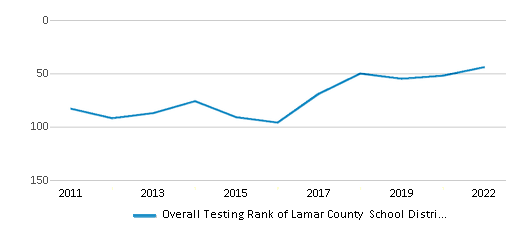
Math Test Scores (% Proficient)
35%
29%
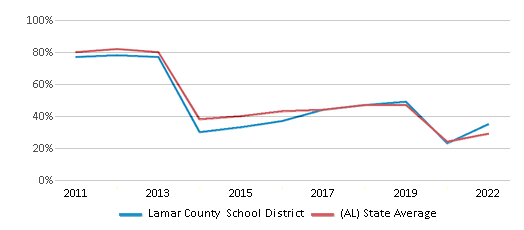
Reading/Language Arts Test Scores (% Proficient)
47%
47%
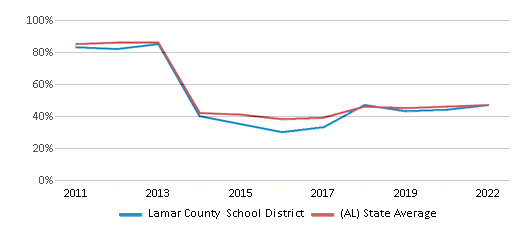
Science Test Scores (% Proficient)
26%
38%
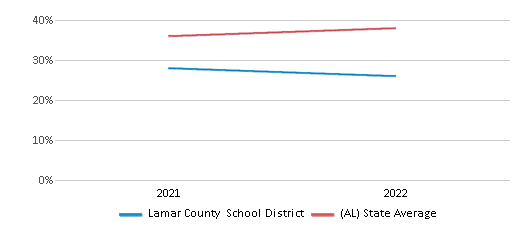
Graduation Rate
85-89%
88%
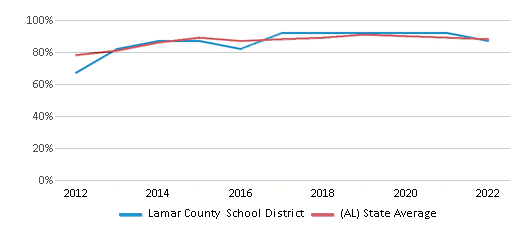
Students by Ethnicity:
Diversity Score
0.29
0.63
# American Indian Students
n/a
5,986 Students
% American Indian Students
n/a
1%
# Asian Students
4 Students
10,976 Students
% Asian Students
n/a
1%
# Hispanic Students
45 Students
83,354 Students
% Hispanic Students
2%
11%
# Black Students
237 Students
234,256 Students
% Black Students
11%
32%
# White Students
1,825 Students
379,490 Students
% White Students
84%
51%
# Hawaiian Students
1 Student
824 Students
% Hawaiian Students
n/a
n/a
# Two or more races Students
64 Students
28,630 Students
% of Two or more races Students
3%
4%
Students by Grade:
# Students in PK Grade:
58
21,953
# Students in K Grade:
191
55,899
# Students in 1st Grade:
153
58,528
# Students in 2nd Grade:
173
57,991
# Students in 3rd Grade:
154
55,161
# Students in 4th Grade:
153
54,236
# Students in 5th Grade:
164
54,179
# Students in 6th Grade:
162
54,861
# Students in 7th Grade:
153
55,768
# Students in 8th Grade:
168
56,376
# Students in 9th Grade:
161
59,139
# Students in 10th Grade:
159
56,986
# Students in 11th Grade:
160
53,181
# Students in 12th Grade:
167
49,258
# Ungraded Students:
-
-
District Revenue and Spending
The revenue/student of $13,294 is higher than the state median of $13,006. The school district revenue/student has stayed relatively flat over four school years.
The school district's spending/student of $10,955 is less than the state median of $12,220. The school district spending/student has stayed relatively flat over four school years.
Total Revenue
$29 MM
$9,671 MM

Spending
$24 MM
$9,086 MM
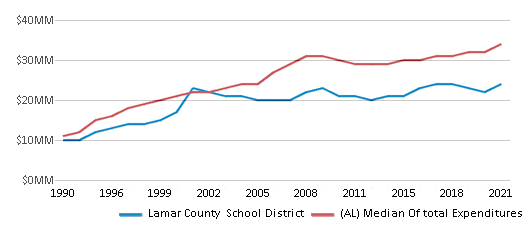
Revenue / Student
$13,294
$13,006
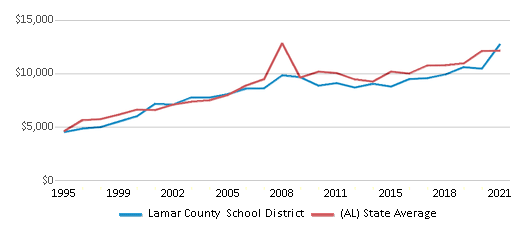
Spending / Student
$10,955
$12,220
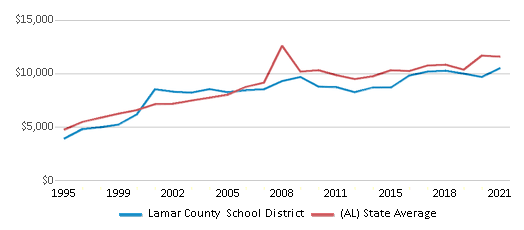
Best Lamar County School District Public Schools (2025)
School
(Math and Reading Proficiency)
(Math and Reading Proficiency)
Location
Grades
Students
Rank: #11.
Vernon Elementary School
(Math: 70-74% | Reading: 70-74%)
Rank:
Rank:
10/
Top 5%10
9700 Hwy 18 W
Vernon, AL 35592
(205) 695-9728
Vernon, AL 35592
(205) 695-9728
Grades: PK-3
| 281 students
Rank: #22.
South Lamar School
(Math: 48% | Reading: 52%)
Rank:
Rank:
8/
Top 30%10
300 Sls Road
Millport, AL 35576
(205) 662-4411
Millport, AL 35576
(205) 662-4411
Grades: PK-12
| 615 students
Rank: #33.
Sulligent School
(Math: 29% | Reading: 51%)
Rank:
Rank:
7/
Top 50%10
500 Elm St
Sulligent, AL 35586
(205) 698-9254
Sulligent, AL 35586
(205) 698-9254
Grades: PK-12
| 693 students
Rank: #44.
Lamar County Highintermediate
(Math: 25% | Reading: 36%)
Rank:
Rank:
5/
Bottom 50%10
8990 Highway 18
Vernon, AL 35592
(205) 695-7717
Vernon, AL 35592
(205) 695-7717
Grades: 4-12
| 587 students
Rank: n/an/a
Lamar County School Of Technology
Vocational School
43880 Hwy 17 South
Vernon, AL 35592
(205) 695-7129
Vernon, AL 35592
(205) 695-7129
Grades: 10-12
| n/a students
Frequently Asked Questions
How many schools belong to Lamar County School District?
Lamar County School District manages 5 public schools serving 2,176 students.
What is the rank of Lamar County School District?
Lamar County School District is ranked #46 out of 145 school districts in Alabama (top 50%) based off of combined math and reading proficiency testing data for the 2021-2022 school year. This district ranks in the top 20% of Alabama school districts for: Highest math proficiency (Top 20%)
What is the racial composition of students in Lamar County School District?
84% of Lamar County School District students are White, 11% of students are Black, 3% of students are Two or more races, and 2% of students are Hispanic.
What is the student/teacher ratio of Lamar County School District?
Lamar County School District has a student/teacher ratio of 17:1, which is equal to the Alabama state average of 17:1.
What is Lamar County School District's spending/student ratio?
The school district's spending/student of $10,955 is less than the state median of $12,220. The school district spending/student has stayed relatively flat over four school years.
Recent Articles

Year-Round Or Traditional Schedule?
Which is more appropriate for your child? A year-round attendance schedule or traditional schedule? We look at the pros and cons.

Why You Should Encourage Your Child to Join a Sports Team
Participating in team sports has a great many benefits for children, there is no doubt. In this article you will learn what those benefits are.

White Students are Now the Minority in U.S. Public Schools
Increasing birth rates among immigrant families from Asia and Central and South America, combined with lower birth rates among white families, means that for the first time in history, public school students in the United States are majority-minority. This shift in demographics poses difficulties for schools as they work to accommodate children of varying language abilities and socio-economic backgrounds.





